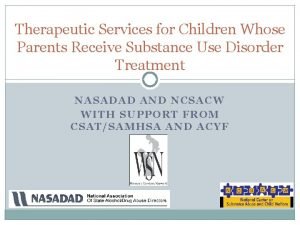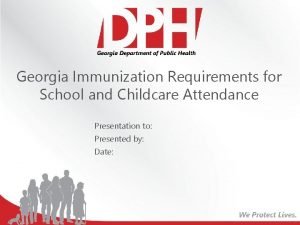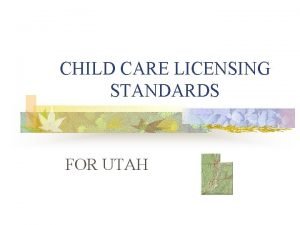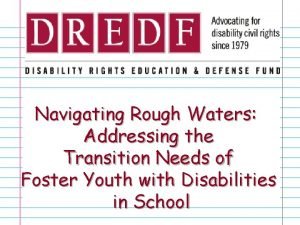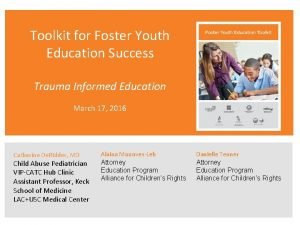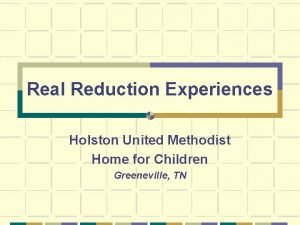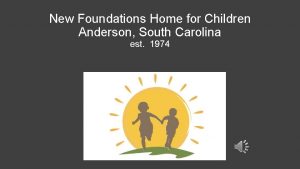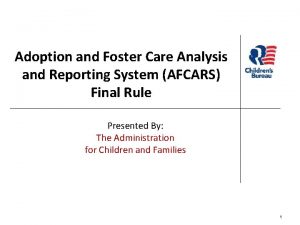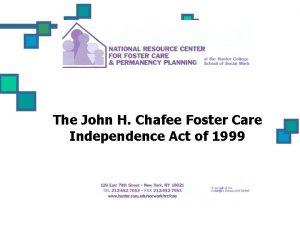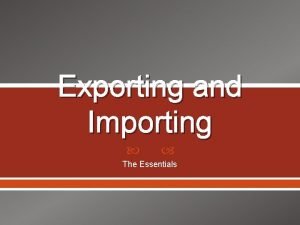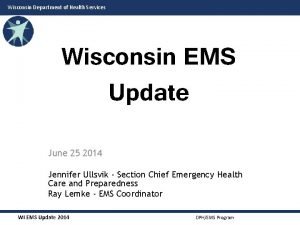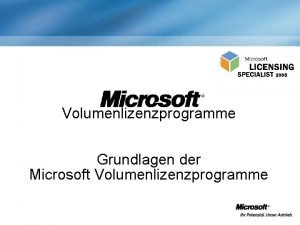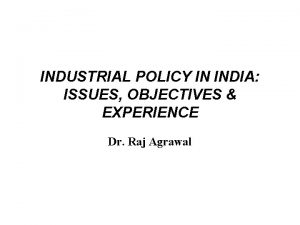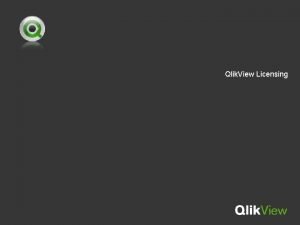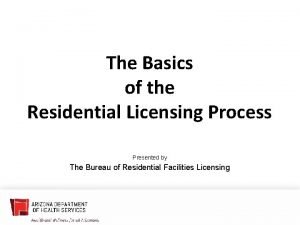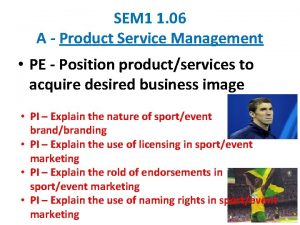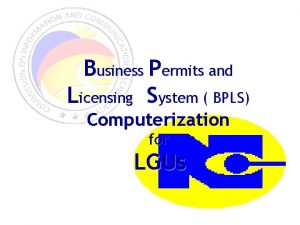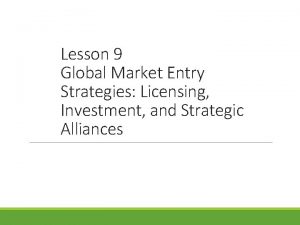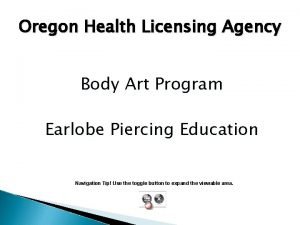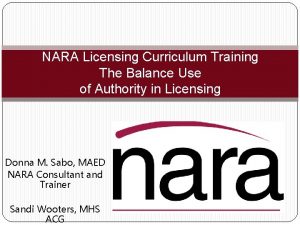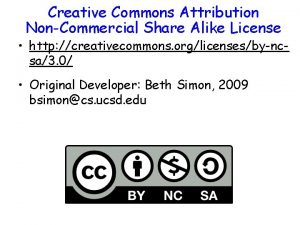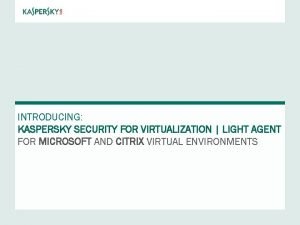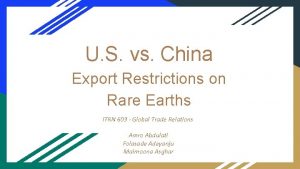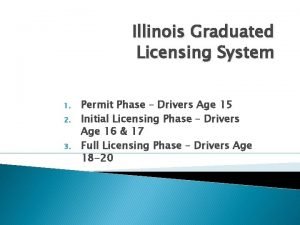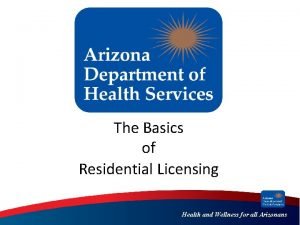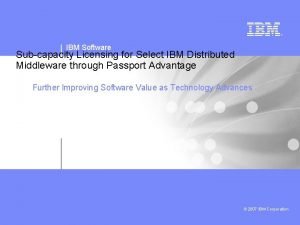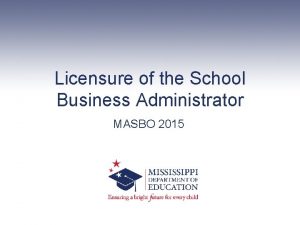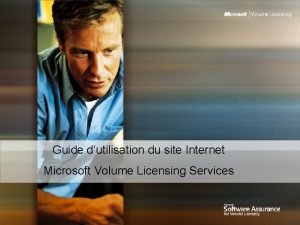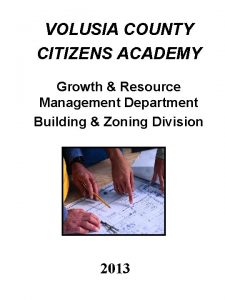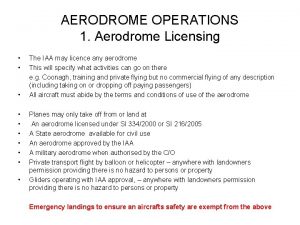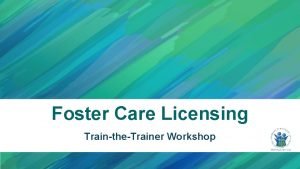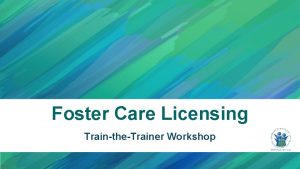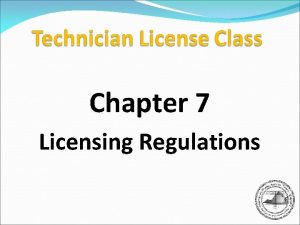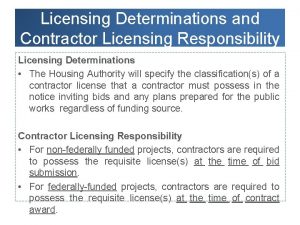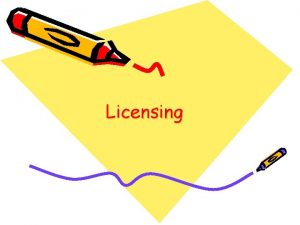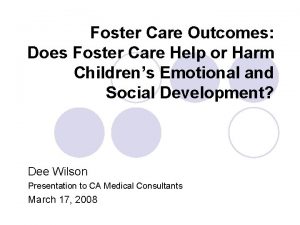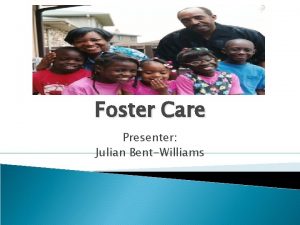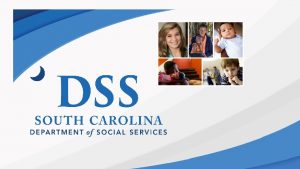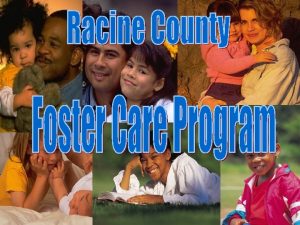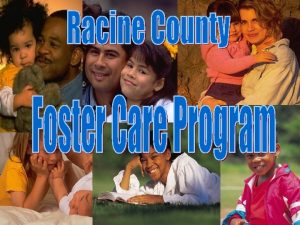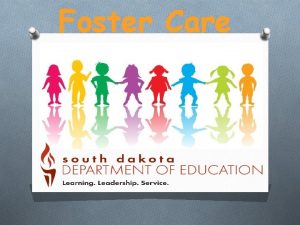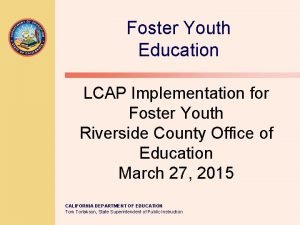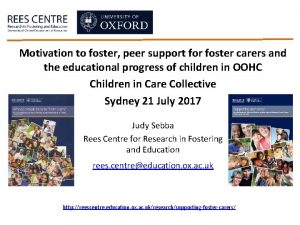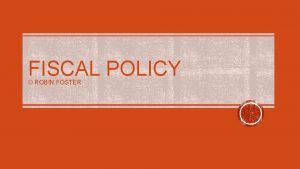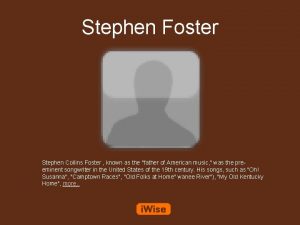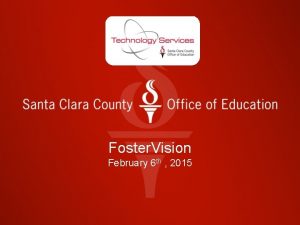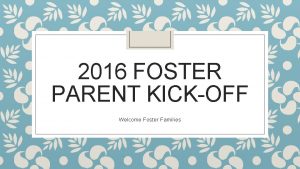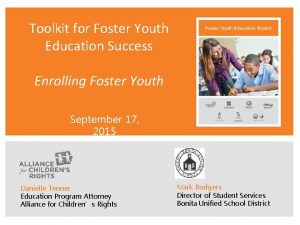Foster Care Licensing TraintheTrainer Workshop Session A Session







































- Slides: 39

Foster Care Licensing Train-the-Trainer Workshop

Session A

Session A Agenda Today, we will cover: § Changes in Title IV-E Waiver § New Levels of Licensure Types § Level I Child-Specific Licensure § Guardianship Assistance Program (GAP)

Session A Objectives After this session, you will be able to: § Explain the sunsetting effects of the Title IV-E Waiver. § Describe the new licensure types. § Explain the Level I child-specific license. § Define fictive kin. § Document fictive kin in FSFN. § Describe the Guardianship Assistance Program (GAP).

Title IV-E Waiver

Title IV-E Waiver Title IV-E Demonstration Waiver allowed the department to: § Waive certain provisions of the Title IV-E Social Security Act. § Use the funds for a wide variety of child welfare purposes rather than being restricted to eligible children in licensed foster care homes or institutions.

Title IV-E Waiver Expiration § The Title IV-E Waiver has been extended until September 2019. § The expiration will result in the loss of approximately $90 million dollars in revenue that fund the CBC services for families and positions.

Path Forward With the sunsetting of the Title IV-E Waiver, DCF, in conjunction with FCC, implemented the Path Forward statewide initiative to maximize additional federal funds in support of the child welfare system. Path Forward initiative includes: §Title IV-E Extended Foster Care (EFC) and Extended Maintenance Adoption Subsidy (EMAS) §Guardianship Assistance Program (GAP) and Extended Guardianship Assistance Program (EGAP) §Title IV-E Eligibility Clean-up §Candidacy

Caregiver Benefits

Unified Home Study with Emergency Placement Child Removed CPI removes a child and places him/her with a relative/nonrelative /fictive kin.

Unified Home Study with Emergency Placement Child Removed CPI removes a child and places him/her with a relative/nonrelative /fictive kin. Background Checks CPI completes background checks of all household members over the age of 12 and frequent visitors over the age of 18 who provide sight and sound supervision under 65 C-28, F. A. C. and 39. 0138, F. S.

Unified Home Study with Emergency Placement Child Removed CPI removes a child and places him/her with a relative/nonrelative /fictive kin. Talk to Caregiver CPI explains the child’s special needs, available support, and danger threats creating the child’s need for out of home placement. Background Checks CPI completes background checks of all household members over the age of 12 and frequent visitors over the age of 18 who provide sight and sound supervision under 65 C-28, F. A. C. and 39. 0138, F. S.

Unified Home Study with Emergency Placement Child Removed CPI removes a child and places him/her with a relative/nonrelative /fictive kin. Talk to Caregiver CPI explains the child’s special needs, available support, and danger threats creating the child’s need for out of home placement. Background Checks CPI completes background checks of all household members over the age of 12 and frequent visitors over the age of 18 who provide sight and sound supervision under 65 C-28, F. A. C. and 39. 0138, F. S. Home Evaluation CPI observes the home for possible dangers and discusses the child’s sleeping arrangements.

Unified Home Study with Emergency Placement Child Removed CPI removes a child and places him/her with a relative/nonrelative /fictive kin. Talk to Caregiver CPI explains the child’s special needs, available support, and danger threats creating the child’s need for out of home placement. Background Checks CPI completes background checks of all household members over the age of 12 and frequent visitors over the age of 18 who provide sight and sound supervision under 65 C-28, F. A. C. and 39. 0138, F. S. Verbal Supervisory Approval CPI obtains supervisor’s verbal approval for the placement before leaving the child in the care of the caregiver. Home Evaluation CPI observes the home for possible dangers and discusses the child’s sleeping arrangements.

Unified Home Study with Emergency Placement Child Removed CPI removes a child and places him/her with a relative/nonrelative /fictive kin. Talk to Caregiver CPI explains the child’s special needs, available support, and danger threats creating the child’s need for out of home placement. Background Checks CPI completes background checks of all household members over the age of 12 and frequent visitors over the age of 18 who provide sight and sound supervision under 65 C-28, F. A. C. and 39. 0138, F. S. Verbal Supervisory Approval CPI obtains supervisor’s verbal approval for the placement before leaving the child in the care of the caregiver. Home Evaluation CPI observes the home for possible dangers and discusses the child’s sleeping arrangements. Child Placed CPI places the child with a relative, non-relative, or fictive kin and finalizes the Unified Home Study.

Unified Home Study with Emergency Placement Child Removed CPI removes a child and places him/her with a relative/nonrelative /fictive kin. Talk to Caregiver CPI explains the child’s special needs, available support, and danger threats creating the child’s need for out of home placement. Verbal Supervisory Approval CPI obtains supervisor’s verbal approval for the placement before leaving the child in the care of the caregiver. Child Resides with Caregiver Background Checks CPI completes background checks of all household members over the age of 12 and frequent visitors over the age of 18 who provide sight and sound supervision under 65 C-28, F. A. C. and 39. 0138, F. S. Home Evaluation CPI observes the home for possible dangers and discusses the child’s sleeping arrangements. Child Placed CPI places the child with a relative, non-relative, or fictive kin and finalizes the Unified Home Study.

Unified Home Study with Planned Placement Caregiver Identified Case manager identifies a relative or non-relative to place the child. Talk to Caregiver Case manager explains the child’s special needs, available support, and danger threats creating the child’s need for out of home placement. Supervisory Approval Case manager’s supervisor approves the home study. Child Resides with Caregiver Background Checks Case manager completes background checks of all household members over the age of 12 and frequent visitors over the age of 18 who provide sight and sound supervision. Home Evaluation Case manager observes the home for possible dangers and discusses the child’s sleeping arrangements. Child Placed Case manager places the child with the relative/nonrelative

Available Caregiver Benefits Child Placed Child Resides with Caregiver Cash Only TANF Assistance Foster Care Board Payment Relative/Non-relative Caregiver Programs

Relative/Non-Relative Caregiver Program vs. Level I Foster Home Relative/Non-Relative Caregiver Program Time Frame Home Study Payment Rate Level I Foster Home 60 – 90 days 60 days $242 -$298 $333 ACCESS Local CBC Licensing Child Support Educational Support Additional Resources Additional Case Mgmt. Completed Through

New Levels of Licensure

Foster Home Licensing Levels of Licensure (409. 175, F. S. ) Level I - Child Specific Foster Home Level II - Non-Child Specific Foster Home (Currently Traditional Foster Home) Level III - Safe Foster Home for Human Trafficking Victims Level IV - Therapeutic Foster Home Level V - Medical Foster Home

Level I Licensed Individuals RELATIVES A person who is related by the whole or half-blood, by affinity, or by adoption. • Grandparent • Great-grandparent • Sibling • First cousin • Aunt, uncle • Great-aunt, great-uncle • Niece or nephew FICTIVE KIN An individual who is unrelated to the child by either birth or marriage but has such a close emotional relationship with the child that he or she may be considered part of the family. • Godparents • Close family friends Determination of non-relative vs. fictive kin depends on the degree of relationship between the caregiver and child. NON-RELATIVES An individual who is unrelated to the child either by birth or marriage but has an existing relationship with the child or the family. This may include; • Teachers • Neighbors • Coaches • People outside of 5 degree

Documenting Fictive Kin in FSFN Maintain Case- Relationship Tab

Documenting Fictive Kin in FSFN Unified Home Study - Relationship to Caregiver

Documenting Fictive Kin in FSFN Out-of-Home Placement - Relationship of Child to Relative Caregiver

Level I-Child Specific Foster Home § Level I license allows relatives/non-relatives/fictive kin to be paid a foster care board rate. § Level I licensure is a tailored process for relatives/non-relatives/fictive kin. Each Trainer will • Background Checks (Ch. 39, F. S. vs Ch. 435, F. S. ) insert local process for • Waivable Non-safety Items educating caregivers and initiating the Level • Streamlined Educational Resources I licensure process. § At initial placement, the CPI or Case Manager will provide an informational brochure to relatives/non-relatives/fictive kin and notify the designated child welfare professional for licensing. The Florida Legislature is considering changes to requirements for background checks and educational resources during the 2019 legislative session.

Level I Foster Parent Inquiry Interested Level I Licensing process starts. Child welfare professional who made the initial placement introduces the family or individual to the opportunity of becoming a Level I licensed foster home. Child welfare professional has 2 business days from placement to notify the designated child welfare professional for licensing. The designated child welfare professional contacts the family or individual within 2 business days of notification (even if the caregiver declines initially). Not Interested Relative, non-relative, or fictive kin signs “Notice Of Non. Participation in Licensure” agreement (upload it to the Provider file cabinet in FSFN). If the caregiver declines initially to be a Level I foster parent; • The designated child welfare professional should contact the caregiver once a month to remind them of the opportunity. • The caregiver still has the opportunity for licensure at a later date.

What is New for Case Managers? Child Removed Talk to Caregiver Verbal Supervisory Approval Notification of CBC within 2 business days Caregiver chooses to be licensed Licensing will complete a Unified Home Study for Level I Foster Home. Within 45 days of transferring the case to case management Case manager will complete a Unified Home Study for Relative/Non-Relative placement. Background Checks Home Evaluation Child Placed Caregiver chooses not to be licensed If licensing does not complete the Unified Home Study within 45 days of transferring the case, the Case Manager must complete an updated home study.

Guardianship Assistance Program (GAP)

Caregiver Benefits Child Placed Child Reunified with Family Permanency Options Cash Only TANF Child is Adopted Permanent Guardianship Relative/Non-relative Caregiver Program Foster Care Board Payment GAP

Guardianship Assistance Program (GAP) Overview § Permanent Guardianship is possible when reunification and adoption have been determined to not be in the child’s best interest. § The Guardianship Assistance Program (GAP) is a Title IV-E benefits program that is available to guardians who commit to care for a child long term. § GAP benefits are provided to a court approved guardian following discharge to permanent guardianship. § GAP benefits are paid to the guardian on behalf of the eligible child.

Guardianship Assistance Program (GAP) Eligibility To be eligible for GAP payments, a child: § Has been placed with the guardian by the court, § Is eligible for foster care room and board payments for at least 6 consecutive months with the current guardian, and § It has been determined that reunification or adoption is not in the best interest of the child. To be eligible for GAP payments, a guardian: § Has committed to caring for a child long term, § Has been licensed to care for the child, § Enters into a Guardianship Assistance Agreement (GAA) for the child prior to discharging to permanent guardianship.

Guardianship Assistance Program (GAP) Benefits GAP benefits are: § Monthly payments of $333 to support the child, § Medicaid benefits until 18 years of age (or 21 if eligible for Extension of Guardianship Assistance Program), § Tuition and fee exemptions, § Available for children who are living out-of-state, § One-time payment to assist with the costs of establishing permanent guardianship ($2000 nonrecurring).

Guardianship Assistance Program (GAP) Myths vs. Facts Myth Fact Relatives, Non-relatives, and Fictive Kin who are licensed automatically qualify for GAP. The caregiver must receive foster care board payments for 6 consecutive months prior to discharge to permanent guardianship. Myth Fact Guardianship Assistance Program payments begin after the caregiver is licensed. The caregiver will receive a foster board payment until discharge to permanent guardianship. Upon discharge, the GAP payments will begin for program eligible children. Myth Fact GAP is a “new” permanency option. GAP is a benefit for children that discharge to permanent guardianship.

Extended Guardianship Assistance Program (EGAP) § Is available to guardians who entered into an initial Guardianship Assistance Agreement (GAA) for a 16 or 17 year old child. § Has the purposes of § Reducing the risk of child remaining in foster care. § Providing additional financial support to guardians. § Allowing CBC lead agencies to provide additional support to guardians. § Is available to the child until 21 if the child participates in at least one or more qualifying activities. § Eligibility redetermination must be completed every 6 months.

Local Referral Process Think about the following questions to determine your local referral process for relatives, non-relatives, and fictive kin. §How much information will the child welfare professional share with caregivers? §How will the child welfare professional who makes the initial placement contact the child welfare professional who is responsible for licensing? §Who will talk to the caregiver? §Which method will be used to contact the caregiver (e. g. , home visit, phone call, etc. )? §How will you follow up with the caregiver if the caregiver initially declines to be Each trainer will licensed? Use Guardianship Readiness Assessment tool (GRA) to answer these questions. insert local process for referring families to initiate the Level I licensure process.

Take Away § With the sunsetting of the Title IV-E Waiver, DCF, in conjunction with FCC, implemented the Path Forward statewide initiative to identify federal funds to support the child welfare system. To draw more federal funding, relatives, non-relatives, and fictive kin can receive foster care board payments. § There are five levels of licensure with the new addition of Level I-Child Specific Foster Home for relatives, non-relatives, and fictive kin. § Level I-Child Specific Foster Home is tailored for relative/non- relative/fictive kin caregivers with modified background evaluation, waivable non-safety items, and streamlined educational resources. Background checks and reduced educational resources will go into effect on July 1 st, 2019 if the legislature passes the language.

Take Away § Guardianship Assistance Program (GAP) is a Title IV-E benefits program that is available to guardians who commit to caring for a child long term. § A child is eligible for GAP payments when he/she is placed with the guardian by the court and receives foster care board payments for at least 6 consecutive months with the current guardian. § GAP benefits include monthly payments, Medicaid, out-of-state living expenses, tuition and fee exemptions, and one-time nonrecurring payment.

 Georgia child care licensing regulations
Georgia child care licensing regulations Ga form 3231 blank
Ga form 3231 blank Child care licensing utah
Child care licensing utah Effects of multiple placements in foster care
Effects of multiple placements in foster care Trauma informed care for foster youth
Trauma informed care for foster youth Holston homes foster care
Holston homes foster care New foundations home for children
New foundations home for children Foster care analysis reporting system
Foster care analysis reporting system Effects of multiple placements in foster care
Effects of multiple placements in foster care John h chafee foster care independence program
John h chafee foster care independence program Primary care secondary care tertiary care
Primary care secondary care tertiary care Export licensing requirements
Export licensing requirements Wi ems e licensing
Wi ems e licensing Microsoft action pack lizenzen übersicht
Microsoft action pack lizenzen übersicht Industries requiring compulsory licensing *
Industries requiring compulsory licensing * Qlikview usage cal
Qlikview usage cal Azdhs residential licensing
Azdhs residential licensing Explain the use of licensing in.sport/event marketing
Explain the use of licensing in.sport/event marketing Bpls system
Bpls system Entry strategy licensing
Entry strategy licensing Oregon piercing license
Oregon piercing license Nara licensing
Nara licensing Creative commons attribution share alike
Creative commons attribution share alike Ldh health standards
Ldh health standards Kaspersky light agent
Kaspersky light agent Industrial licensing policy 1991
Industrial licensing policy 1991 Licensing and regulation division
Licensing and regulation division Veritas vems
Veritas vems Export licensing requirements
Export licensing requirements Illinois graduated license
Illinois graduated license Module 4 - open source software and licensing
Module 4 - open source software and licensing Azdhs residential licensing
Azdhs residential licensing Sap renewal negotiation
Sap renewal negotiation Ibm sub capacity licensing
Ibm sub capacity licensing School business administrator licensing
School business administrator licensing Microsoft mlvs
Microsoft mlvs Licensing sports marketing
Licensing sports marketing Ndsu email login
Ndsu email login Volusia county permit center
Volusia county permit center Iaa licensing
Iaa licensing
